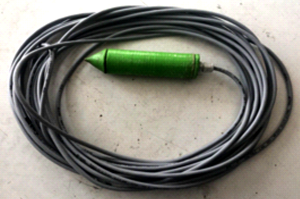Human steps detection using CME and FCME threshold calculation algorithms
DOI:
https://doi.org/10.3103/S0735272722050053Abstract
The problem of object perimeter protection by human steps detection using autonomous seismic activity sensors is solved in this paper. The results of the CME (consecutive mean excision) and FCME (forward consecutive mean excision) algorithms to calculate these sensors threshold level are presented. The algorithms are tested on real experimental data. The number of false alarms for CME and FCME algorithms is equal to 23% 10%, respectively, operating with the envelope of seismic signal. The possibilities to reduce the number of false alarms for algorithms are explored. The signal trend neutralization allows us to reduce the probability of false alarms to 16% and 7% for the CME and FCME algorithms, respectively. The signal amplitude normalization in the analysis interval makes it possible to reduce the number of false alarms to a negligible value. The results allow us to choose the algorithm depending on the input data specifics. The CME algorithm with preliminary normalization of the signal amplitude is the most appropriate to solve the problem of human steps detection by autonomous sensor due to less computational complexity.
References
- G. F. Miller, H. Pursey, E. C. Bullard, “On the partition of energy between elastic waves in a semi-infinite solid,” Proc. R. Soc. London. Ser. A. Math. Phys. Sci., vol. 233, no. 1192, pp. 55–69, 1955, doi: https://doi.org/10.1098/rspa.1955.0245.
- I. O. Sushko, Y. V. Vistyzenko, A. V. Movchanyuk, R. V. Antypenko, A. V. Serha, “Geophone equivalent circuit for simulation tasks in SPICE packages,” Visnyk NTUU KPI Seriia - Radiotekhnika Radioaparatobuduvannia, no. 77, pp. 53–59, 2019, doi: https://doi.org/10.20535/RADAP.2019.77.53-59.
- M. S. Richman, D. S. Deadrick, R. J. Nation, S. Whitney, “Personnel tracking using seismic sensors,” in Proc. SPIE 4393, Unattended Ground Sensor Technologies and Applications III, 2001, pp. 14–21, doi: https://doi.org/10.1117/12.441276.
- J. Li, M. He, G. Cui, X. Wang, W. Wang, J. Wang, “A novel method of seismic signal detection using waveform features,” Appl. Sci., vol. 10, no. 8, p. 2919, 2020, doi: https://doi.org/10.3390/app10082919.
- G. Koç, K. Yegin, “Footstep and vehicle detection using slow and quick adaptive thresholds algorithm,” Int. J. Distrib. Sens. Networks, vol. 9, no. 10, p. 783604, 2013, doi: https://doi.org/10.1155/2013/783604.
- Y. J. Kang, J. Lee, J. Bea, C. H. Lee, “Footstep detection and classification algorithms based seismic sensor,” J. Inst. Electron. Inf. Eng., vol. 52, no. 1, pp. 162–172, 2015, doi: https://doi.org/10.5573/ieie.2015.52.1.162.
- J. Vartiainen, Concentrated Signal Extraction Using Consecutive Mean Excision Algorithms. Oulu: Oulu University, 2010, uri: http://jultika.oulu.fi/Record/isbn978-951-42-6349-1.
- H. Iwata, K. Umebayashi, S. Tiiro, Y. Suzuki, J. J. Lehtomaki, “A study on Welch FFT segment size selection method for spectrum awareness,” in 2016 IEEE Wireless Communications and Networking Conference, 2016, pp. 1–6, doi: https://doi.org/10.1109/WCNC.2016.7564679.
- J. Vartiainen, J. Lehtomäki, H. Saarnisaari, M. Juntti, “Analysis of the consecutive mean excision algorithms,” J. Electr. Comput. Eng., vol. 2010, pp. 1–13, 2010, doi: https://doi.org/10.1155/2010/459623.


